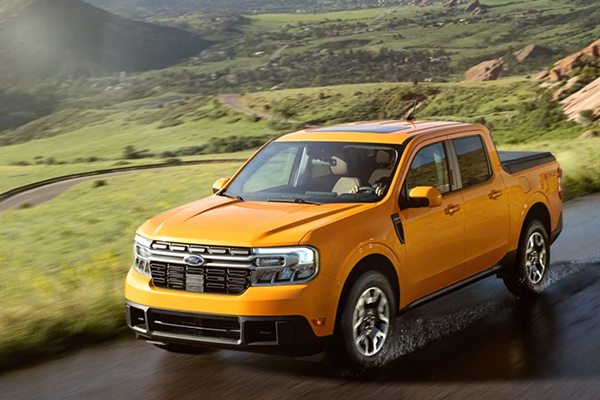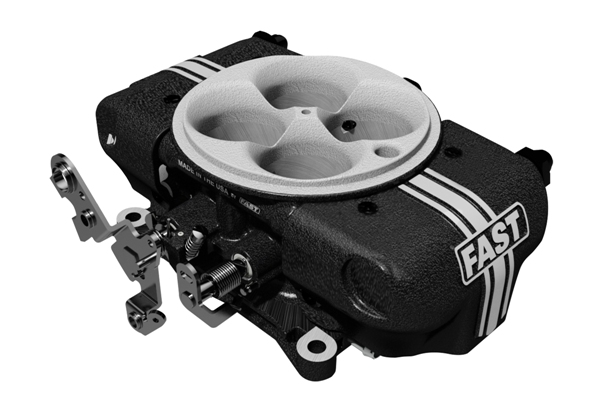
Before Phil Floraday got married, he thought it was perfectly normal to buy cars that didn’t run. He’d make the purchase, remove the parts that he needed, sell the other parts for pocket change and then scrap any leftover sheet metal. In fact, he shares–on his bio as senior web editor for Automobile magazine–that this is how he used to spend his spring breaks. Then, once he had too many pieces and parts lying around, he did the only reasonable thing. He bought a house so that he would have a garage so that he could conveniently store all of his non-working vehicles.
“It was a good way to spend time in my twenties,” Phil says, “because I learned about cars by taking them apart and it seemed cost effective. I eventually learned that I wasn’t taking into account my time, though, which is valuable. And, after I realized that, I’m not fighting rusty bolts so often.”
Phil got a photojournalism degree at Ohio University, following that up with an internship with Auto Week. “I started out by working on the back end of the site,” Phil says, “and then a fulltime job opened up there that gave me more experience with editorial.”
As time passed, Phil’s sets of wheels improved for two reasons: one, he got to test vehicles as part of his Auto Week job; and, two, he got married, which meant that his garage now needed to contain vehicles–and lawnmowers–that worked.
24 Hours of LeMons
Phil has also been a participant in 24 Hours of LeMons races, in which the racing vehicles cannot cost more than $500. “I raced with an 87 Pontiac Fiero,” Phil shares. “I was never able to complete my early races, though, because the car would get hit and something would break, or else it would stall out. My car was always pretty beaten up, too, even by $500-car standards, and I’d need to be wrenching the car while driving it, which is quite the experience.” He also recalls when a gas gauge didn’t work in a LeMons vehicle but, fortunately, his bucket of junk never ran out of gas.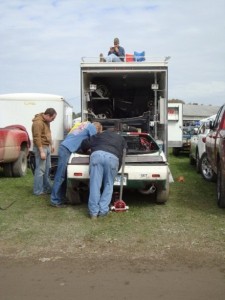 Phil and his team work on their LeMons Fiero.
Phil and his team work on their LeMons Fiero.
Automobile magazine
When Phil first got a job at Automobile, his duties were “much more nuts and bolts” as he converted stories that originally appeared in the company’s print publication to be suitable for online use; found extra photos, since the Internet allows for more illustration; reviewed new cars that were launching; and “spent too much time in planes.”
After marrying three years ago, he cut back on travel and began taking on a more active role in shaping the look and function of the online publication, and overseeing a “complete overhaul of the car buyer’s guide.” He also monitors the social media channels associated with the magazine, watching for and responding to any signs of discontent by fans and followers. He used to attend more car trade shows than he does now, in part because of his shifting work responsibilities and in part because manufacturers now reveal most of the information about new launches before the show starts.
“So, attending shows is not as critical,” Phil explains. “There is no substitute for seeing the cars, but we generally already have the pertinent info and then we simply have a few reps check out the actual show.”
Automobile magazine describes itself in this fashion: America’s leading automotive lifestyle publication. Arbiters of the “All-Star” awards. Profiles upcoming car designs from leading manufacturers. Written for the sophisticated enthusiast. Profiles high-end vehicles with compelling editorial & photographic content.
When asked how he defines a “sophisticated enthusiast,” Phil said the following: “Well, if you have faith in reader surveys, our readers are better educated and better off financially than the average reader of other major car magazines, especially when you’re talking about print subscribers. We’re also more literary. I like to describe Automobile as a men’s magazine that happens to feature cars, rather than a car magazine that happens to have well written articles. We believe that the road we take is every bit as important as the car.”
As two examples of quality literary reads found within the online magazine’s virtual pages:
- Noise, Vibration & Harshness: A Boy's First Sinkhole: a heartwarming story about a dad, his son – and, of course, a car
- Noise, Vibration & Harshness: Going, Going, Gone: touching lament about the disappearing connection between driving and AM radio
All-Star Awards
Each year, Automobile recognizes ten vehicles for excelling in whatever ways they are designed to excel. This list can include trucks, sedans, luxury vehicles, economy cars–whatever fits the bill. If a vehicle continues to excel from year to year, it can stay on the list indefinitely, unlike many other “best of” lists that only recognize new entries to the field. And, by the way, if you’re looking for exact guidelines and qualifications established for choosing winners, you won’t find them. As the article revealing the 2013 winners says, “We claim no objectivity.”
Automobile: print versus online
“Online,” Phil says, “there is more consumer reach. For instance, some vehicles that aren’t covered in print, because they wouldn’t appeal to those readers, find their way online. We have the same ‘take’ on vehicles, online and in print, but we can cover a broader selection in our car buyer’s guide on the Internet. What matters most is in print, but everything else can be on the website – and features that are designed for print will eventually be uploaded online, too.” Phil competes in LeMons. Photo by Murilee Martin.
Phil competes in LeMons. Photo by Murilee Martin.
Predictions for the future
Phil’s answer is short and sweet: autonomous driving.
By this, he means the type of driving in which the vehicle’s computer manages its own acceleration, braking and steering, without any need for the human inside the vehicle to push, pull, press or turn anything on off, up or down. Meet the Jetsons, anyone?
“At every show,” Phil continues, “that’s the topic. Each manufacturer’s approach is a bit different, with some wanting the driver to be on standby in case he or she needs to jump in and participate in driving, while others are trying to take people out of the process entirely.”
The technology is moving forward in steps, with features such as emergency stop assist, traffic jam assist, speed limit assist and automatic parallel parking in various stages of development.
One of the earliest examples of this technology is demonstrated in vehicles with smart cruise control, which causes a car to slow down or speed up, based on the distance between its front bumper and the rear bumper of the vehicle directly ahead. “When you’re in these cars,” Phil says, “you have to wonder–‘is it really going to stop?’ For the most part, they work and, really, they’re surprisingly good– but I still don’t know if I 100% trust the system.” Recently, an assistant editor of Automobile sat behind the wheel of one of the more advanced autonomous cars and said he felt like a “passenger in the driver’s seat.”
So . . . what does Phil think about this trend? “I’m not a huge proponent,” he admits. “I want people to have the driving experience. Face it, at Automobile, we still like manual transmissions. We believe in man-machine interaction because of the amount of joy you can get from really good transmission, from really good brakes. You blend into the car and become like one.”
And, the automated vehicle? “Complete opposite,” Phil announces. “Drivers are taken out of the equation.”
Automated vehicles: a deeper look
Wired shares a prediction that, by 2040, you will no longer need a driver’s license–because you will technically no longer be driving; rather you will be being driven. This raises the question of–what will that do to car insurance prices? Will companies decide that a person–or his or her automated car–is the better bet as far as risk? If cars are chosen as the better drivers, that’s good for your pocketbook . . . but kind of insulting. I mean, c’,mon. If, however, cars are determined to be more risky as “drivers,” then that’s an added expense, besides the estimated $3,000 or so that will be added to a vehicle’s price when it is fully automated.
Traffic lights? Stop signs? Speed limits? Who needs ‘em??
And, the time of automation is drawing nearer, as:
- General Motors’ Cadillac division projects:
- partially autonomous cars on a large scale by 2015
- fully autonomous cars by the end of the decade
- Audi and BMW have conceptually created self-driving vehicles
- Google uses a fleet of fully autonomous Toyota Prius hybrids, already having put 300,000 miles on their odometers
- The Institute of Electrical and Electronics Engineers has predicted that, by 2040, 75% of vehicles being used will be autonomous
- Vehicle-to-vehicle communications are being tested, which will allow cars to talk to one another, so to speak, to avoid crashes
- Volvo is testing “road trains” in Europe, which consists of vehicles moving very closely to one another; this would be possible with automation and would allow more cars on the road, with lower fuel consumption
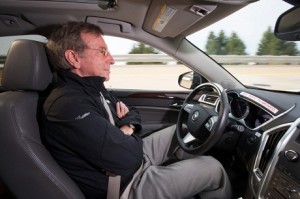 Cadillac Super Cruise 01: Jeremy Salinger, General Motors R&D manager for Super Cruise. Photo copyright General Motors.
Cadillac Super Cruise 01: Jeremy Salinger, General Motors R&D manager for Super Cruise. Photo copyright General Motors.
And, of course, what’s the world of driving without competitions–in this case, the DARPA Urban Challenge, where teams needed to build automated vehicles that can drive themselves in traffic safely and effectively. Events were held in 2004, 2005 and 2007, representing the first time that traditionally driven cars intermingled normally with autonomous ones in a typical road environment.
Five stages of autonomy
To get answers to some practical questions, we talked to Steve Garfink of Seer Communications, a business writer who consults with companies, research groups and governmental agencies that are focusing on the transition from human driving to autonomous driving. Steve explains that the technologies needed for autonomous driving are being introduced in stages, with the National Highway Traffic Safety Administration (NHTSA) listing these five levels:
- Level 0: no automation, with the driver needing to be in complete control of steering, braking and the like at all times
- Level 1: function-specific automation, where vehicles have at least one automated feature, such as adaptive cruise control, electronic stability control or pre-charged brakes, which help a driver brake more quickly
- Level 2: the combination of two or more autonomous technologies, such as adaptive cruise control and lane centering; in this level, a driver must be prepared to take manual control of his or her vehicle back at any time. Some of these technologies may only be workable in highway driving, in favorable weather conditions and the like.
- Level 3: in this level, drivers will not need to constantly monitor road conditions; rather, he or she will be given a reasonable amount of time to transition from the autonomous driving experience to the more traditional manual driving; in theory, a driver of a level 3 car would, according to Steve, presumably “be free to talk on the phone, text, read the paper, or do whatever else they want knowing they will have plenty of reaction time before they have to pay attention to the road.” When this type of driving becomes available, a long trip could become a productive time, without the “tension of navigating among the big rigs plying” the highway.
- Level 4: the vehicle can handle all “safety-critical driving functions,” and can simply provide destination/navigation information; this vehicle could be occupied or unoccupied.
“The big question, in my view,” Steve shares, “is whether Level 2 vehicles will be treated by their drivers as Level 3 vehicles, making this a distinction without much meaning. It is going to be very interesting to see how this plays out.”
Steve expects that, at least in California, level 1 and level 2 types of cars will not be saddled with regulation, while level 3 and level 4 cars will be regulated. Therefore, because the average person is not fond of needing to abide by more regulations, car manufacturers have a vested interest in having their vehicles categorized as level 1 or 2.
Steve shares a specific example, in which Cadillac is stating that its “Super Cruise” technology is level 2; this technology will allow people to drive without needing to use their hands or feet, probably by the end of this decade. “What is unclear,” Steve says, “is how Cadillac will ensure that they driver remains attentive, though there are technologies in test that monitor eye position in order to alert the drivers if their focus wanders too much.”
When asked if he thought that increased vehicle autonomy was a positive or negative trend, he replied with, “I think the question is moot: it is the direction the industry is heading.” In a white paper titled Driverless Cars Ahead: Get Out Front or Get Run Over!, he states that “those who fail to adjust in a timely manner will surely share the fate of the whip & buggy business early in the 20th century.”
Steve believes that there is a good reason that the auto industry is moving towards automation. “There is fairly general agreement,” he says, “that these technologies promise the most dramatic reduction in accidents–and their attendant costs, which is hundreds of billions of dollars yearly, in lives, injuries and property damages–ever experienced in the automobile's history, simply because human error plays a role in 90%+ of all accidents.”
So, Steve lists the following benefits of “removing the human from the equation” will:
- comparably reduces accidents over the coming decades.
- eventually eliminate most traffic congestion
- decrease the need for highway expansion (basically, because the automated vehicles can operate bumper-to-bumper at higher speeds), thereby reducing both fuel consumption and emissions per mile
“However,” he adds, “the biggest value will be the time freed up from the task of driving. Soon everyone will have low cost access to a 24/7 incredibly reliable and safe chauffeur.”
Regulatory Hurdles
To find out more about anticipated regulations associated with an automated car, Advance Auto Parts reached out to the office of Paul Laurenza, a member of the national law firm of Dykema Gossett, who counsels automotive clients on federal regulatory and litigation issues. According to Paul, the NHTSA’s preliminary policy statement “recognizes the potential safety and other benefits from increasing automated driving, as well as the importance of regulatory policy not impeding continued innovation. On the other hand, the statement voices clear concern regarding overly permissive operation of automated technologies, cautioning the states against allowing operation of self-driving vehicles, except for testing purposes, and offering detailed recommendations in the testing context.”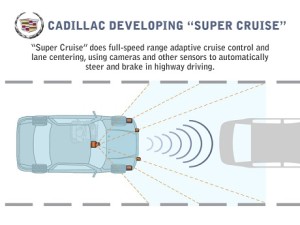 Cadillac Super Cruise 02. Photo copyright: General Motors.
Cadillac Super Cruise 02. Photo copyright: General Motors.
Does driving an automated car appeal to you?
In the 2012 U.S. Automotive Emerging Technologies Study, 20 percent of those surveyed said they “definitely would” or “probably would” be willing to pay an additional $3,000 for an automated car; before the additional cost was disclosed, 37 percent of drivers expressed interest in the technology.
Not surprisingly, people expressing the most interest in autonomous driving are males, especially those between the ages of 18 and 37, and especially those living in urban areas. People who are excited about the trend see these benefits:
- Careless drivers would no longer be responsible for controlling the actions of their automated vehicles
- Drivers can be free to simply enjoy the ride, sort of like taking public transportation but in your own private vehicle
The study also talked to people who “see autonomous driving as the loss of status and would not want to give up the pleasure of driving.” Sounds a lot like Phil Floraday’s point of view!
Still others would appreciate the availability of autonomy during times of “boring” driving, such as the same old, same old daily commute; but, when going on a pleasure cruise, they would want to take back control.
Editor's note: How about you? Are you ready and willing to turn over the reins of your vehicle to . . . well, to your vehicle? Leave your comments below.

